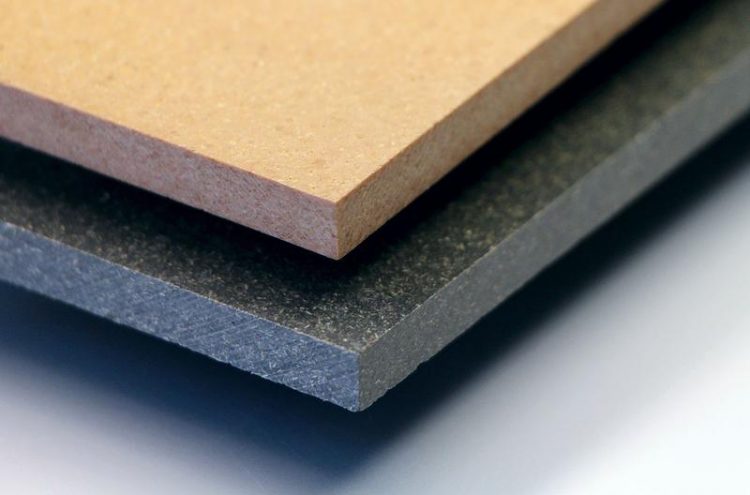Interzum 2015: WPC furniture with low flammability

WPC board without (above) and with (below) flame-proofing. © Fraunhofer WKI
Resource-saving wood-polymer composites (WPCs) are the latest trend in materials for garden furniture and other outdoor applications, especially for terrace decking and also for weatherboarding and fencing panels.
As part of the EU-sponsored LIMOWOOD project, researchers at the Fraunhofer Institute for Wood Research, Wilhelm-Klauditz-Institut WKI in Braunschweig are now collaborating with industrial partners in Belgium, Spain, France and Germany on the development of materials suitable for pressing into moisture-resistant WPC boards for indoor furniture manufacturing.
These boards are composed of around 60 percent wood particles and 40 percent thermoplastic material, generally polypropylene or polyethylene. Both wood and plastic components can be sourced from recycling streams.
The wood component in WPC boards can be replaced by other lignocellulose products derived from the fibrous part of plants such as hemp or cotton, or the husks of rice grains and sunflower seeds. All of these materials are 100-percent recyclable. Moreover, the pressed WPC boards produced by the WKI researchers are formaldehyde-free.
“The controversial question of formaldehyde emissions due to the binder used in conventional pressed wood products is therefore not an issue in this case,” says WKI research scientist Dr. Arne Schirp.
By choosing appropriate additives, the researchers were able to enhance the fire-retardant properties of their WPC boards. They initially developed their formula on a laboratory scale, using commercially available, halogen-free fire retardants which were added to the wood-polymer mixture during the melt phase.
The first step involved determining the limiting oxygen index of the item under test: this parameter defines the behavior of plastics or wood-filled plastic compounds when exposed to flames. It represents the minimum concentration of oxygen at which the material will continue to burn after catching fire. The higher this value, the lower the material’s flammability. Schirp and his colleagues obtained the best results with a combination of fire retardants such as red phosphorus and expanded graphite.
The limiting oxygen index of WPC boards treated in this way extends up to 38 percent, provided the wood particles they contained were also flame-proofed. By comparison, the limiting oxygen index of a standard wood particle board is 27 percent, and that of an untreated WPC board is 19 percent. Even in a single-flame source test, in which a Bunsen burner is held against the test sample, the treated WPC boards demonstrated a high fire resistance. Even after 300 seconds’ exposure, the boards didn’t catch fire. By contrast, the reference samples – of a standard wood particle board and an untreated WPC board – caught fire and continued to burn.
Another particular feature of the new WPC material is that it absorbs very little water and is thus highly suitable for use in bathrooms and kitchens. Even after being immersed in boiling water for five hours, the material emerges intact, whereas conventional wood particle board was completely destroyed by this test. The only limiting factor on applications of WPC is its inability to support high static loads. But even here, it has been possible to increase its bending strength to a level that far exceeds that of conventional particle board by utilizing a judicious mix of component materials.
Wood-polymer composites can be produced in many ways. The most commonly used processes are injection molding and extrusion, in which the various components – wood fibers, thermoplastic materials, and additives – are melted under high pressure at a high temperature and formed in a continuous mold. Arne Schirp’s team has placed its focus on press technology, because it is the best way to produce boards for use in furniture construction.
“The resulting boards have the same visual appeal as all-wood products and can be glued or screwed together to produce attractive furniture. They’re suitable for all decorative, non-loadbearing elements.” But there are many other applications for wood-polymer composites, including exterior weatherboarding of buildings, the construction of trade-show booths, and interior fittings for houses and ships.
Through their development work, the partners in the LIMOWOOD project aim to fill the gap between the high and low ends of the furniture market, which ranges between expensive and not necessarily ecologically sound materials and cheap products made of particle or fiber board, which at present are mainly produced using formaldehyde-based binders. The WKI researchers will be presenting prototypes of their flame-resistant WPC boards at the Interzum trade show in Cologne from May 5 to 8 (Boulevard, B077).
Media Contact
All latest news from the category: Trade Fair News
Newest articles

First-of-its-kind study uses remote sensing to monitor plastic debris in rivers and lakes
Remote sensing creates a cost-effective solution to monitoring plastic pollution. A first-of-its-kind study from researchers at the University of Minnesota Twin Cities shows how remote sensing can help monitor and…

Laser-based artificial neuron mimics nerve cell functions at lightning speed
With a processing speed a billion times faster than nature, chip-based laser neuron could help advance AI tasks such as pattern recognition and sequence prediction. Researchers have developed a laser-based…

Optimising the processing of plastic waste
Just one look in the yellow bin reveals a colourful jumble of different types of plastic. However, the purer and more uniform plastic waste is, the easier it is to…



